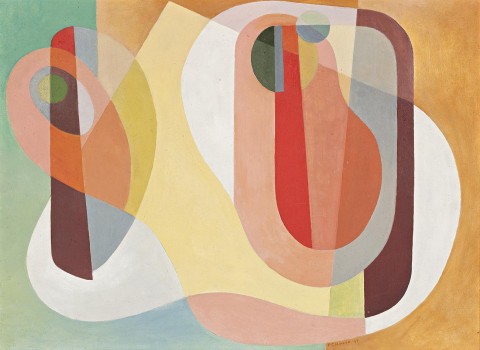PAINTING, 1949
FRANK HINDER
tempera on board
44.5 x 60.5 cm
signed and dated lower right: F.C. Hinder – 49
signed, dated and inscribed with title verso: “PAINTING – 49” / F.C. HINDER / …
Von Bertouch Galleries, Newcastle (label attached verso)
Private collection, New South Wales
Frank Hinder, Toorak Art Gallery, Melbourne, 20 September – 2 October 1970, cat. 29
Frank and Margel Hinder: Retrospective, Newcastle City Art Gallery, Newcastle, 30 August – 30 September 1973, cat. 24
Thomas, D., Frank and Margel Hinder: Retrospective, Newcastle City Art Gallery, Newcastle, 1973, p. 7
Frank Hinder was amongst a handful of vanguard Sydney artists credited with bringing abstract and kinetic art to Australian shores during the interwar years. Grace Crowley, Rah Fizelle and Ralph Balson, Hinder and his wife, the sculptor Margel, were committed to a Modern redefinition of visual culture, seeking a universal truth contained within the purest of pictorial elements: simple shapes and pure colours. Dedicated internationalists, they had all received formal artistic training overseas, Crowley, Fizelle and Balson in Europe and Hinder in the United States. Amongst these artists, Hinder was particularly attentive to the scientific and spiritual potential of abstract art, writing in his diary in 1938 – ‘Are we all here for a certain purpose? The scientist to discover and prove, the philosopher to speculate, the artist to make visible and understandable their discoveries’.1
Painting, 1949 belongs to a series of important geometric ‘Constructive abstract’ paintings, all executed in tempera and pencil between 1942 – 53 and featuring a complex imbrication of planes and discs of pure, shimmering colour.2 Using this simple vocabulary of geometric forms, Hinder attempted to illustrate what he felt was the interconnectedness of all things, viewing the universe as a complex machine, whose parts all moved together in time. As opposed to Crowley and Balson, Hinder’s paintings always retained a link, however fragile, to figuration. His abstract works of this time were produced in tandem to figurative sketches of animals and urban scenes, stylistic elements of which informed his constructive abstracts.
While living in New York between 1929 – 30, Frank Hinder had studied at the New York School of Fine and Applied Art, where he learnt of Jay Hambidge’s compositional theory of ‘dynamic symmetry’ based on logarithmic spirals in the natural world and in ancient Greek art.3 Hinder became enamoured with this idea of a natural set of rules governing the visual world and sought to illustrate it using careful constructions of harmonious colour, balance and proportion. Hinder correlated some of this visual research with music, giving several of his abstract paintings from this period musical titles, for example Red Fugue, 1948. However, Painting is unapologetically formalist in both subject matter and title.
While many of Hinder’s constructive abstracts from this period feature sharp angles and shard-like triangles (prefiguring his later crystalline compositions) Painting is defined by its tight composition of curves, more clearly associated with vortices and the mechanics of motion. Its sinuous and curvilinear forms are translucent and intertwined so as to create a uniquely harmonious and compact composition. In a similar manner to Yellow Abstract, 1948 (in the collection of the National Gallery of Australia, Canberra) and Abstract Painting, 1951 (in the collection of the Art Gallery of New South Wales, Sydney), the dynamic nature of the composition is tethered to the picture plane by an overarching triangular structure. It is through a chromatic contrast between planes of pure colour, and the tertiary colours introduced at each intersection, that Hinder creates a sense of depth. Using Albert Gleizes’ system of rotation and translation, the planes of Painting seem to gently swivel, mapping the relationships between themselves in space under our very eyes.
Even as a purely rational and analytical abstract painting, Painting 1949, is warm and inviting. The luminosity of Hinder’s delicate tempera creates a lush and even surface, and the high-key chromatic register expresses cleanly the joy of harmonious design and the artist’s profound excitement and optimism in the possibilities of Modern urban life.
1. Constructive Abstracts 2 1942 – 1953, Frank Hinder online catalogue raisonné [http://www.frankhinder.com.au/artworks.php]
2. Many of these works were exhibited together in the retrospective shows of Newcastle or Sydney, in 1973 and 1980 respectively.
3. Gascoigne, H., ‘Frank Hinder’s ‘futuropolis’’, Sydney Moderns: Art for a New World, Art Gallery of New South Wales, Sydney, 2013, p. 192
LUCIE REEVES-SMITH
